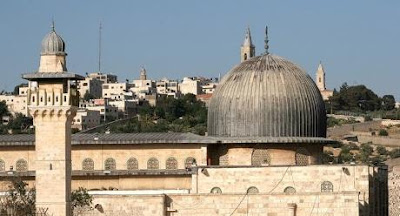
Friday, July 31, 2009
On My Own At Absolute Zero. Nearly.

Saturday, July 25, 2009
Sermons in Stones

Tuesday, July 21, 2009
Borders and Dreams

Sunday, July 19, 2009
Solid Ground

I have just returned from the-place-with-no-name-that doesn’t exist here. It is a place where cultures meet, ancient stones speak and a pervasive sense of one’s own metanarrative in history is focused. Beside its northern lake, it’s a long stroll indeed from one side to the other, especially when walking on water. Much as I would like the phrase ‘paradigm shift’ along with ‘small miracle’ to be consigned permanently to Room 101, the ground itself clothes biblical history with context and purpose.
Almost everywhere, there are suggestions of possibility. A bland, brown sign directs one to the site attributed to the Miracle of the Loaves and Fishes, in fact a stretch of rather grubby beach, the Mount of the Beatitudes crowns a natural amphitheatre and Peter’s house in Capernaum is topped like a maraschino cherry with a modern Catholic church with a glass floor so the archaeological findings underneath are visible during Mass.
Which got me thinking about miracles. I do still wonder if and how it was done, the apparent gravitational reversal of a 600 newton weight being supported on a freshwater liquid surface, apparently with only surface tension to oppose it. But, things may not be as they seem. Snails seem to manage it on an everyday basis, with no visible means of forward propulsion, but we would need shoes the size of football pitches to reproduce the trick.
I read this the other day. In the formation of droplets in a stream of falling sand, scientists have witnessed a dynamic that points beyond the boundaries of traditional physics, and may represent an aspect of a fifth state of matter. Sand as it falls is seen to agglutinate, against all known laws of adhesion and cohesion, into what appears to be droplets, made up of many grains. It seems that the droplets are formed because of instabilities in atomic forces which attract sand grains to each other. Something similar happens to water falling from a faucet, but the forces acting on those molecules are very much larger.
Measurements of this phenomenon, published soon in Nature, overturn the previous explanation for sand droplets — that grains stick to each other after colliding — and quantify what’s called an “ultralow-surface-tension regime.” It’s entirely new territory, and just one of many dynamics governing the behaviour of granular materials, which for reasons unknown act sometimes as solids, or liquids, or gases — or something in-between. The image speaks for itself.
A Chicago researcher wrote “You walk on the beach, and the sand supports your weight. Pick up a handful, and it runs through your fingers, like a liquid. But you can’t walk on water. In the top of an hourglass, sand is (at the verge of) being a solid; it flows through the middle as something like a liquid, and then it’s a solid again,” Ah. Perhaps water might be granular after all. I should dearly love to believe it, rather than in an apocalyptic theology of comfort to a beleaguered community.
Wednesday, July 01, 2009
Special Places
